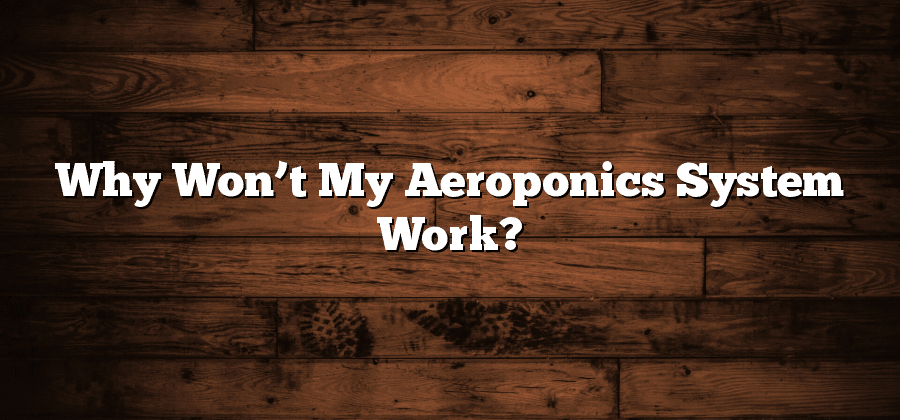Understanding the Basics of Aeroponics Systems
Aeroponics systems are a cutting-edge technology revolutionizing the way plants are grown. This innovative method eliminates the need for soil and instead delivers nutrients to the plant roots through a mist or fog. By suspending the plants in the air and periodically misting them with a nutrient-rich solution, aeroponics allows for maximum oxygenation and nutrient absorption.
One of the key advantages of aeroponics is the ability to grow plants in a highly controlled environment. With the absence of soil, diseases and pests often associated with traditional farming methods are minimized. Additionally, the precise delivery of nutrients and water to the roots ensures that plants receive optimal nutrition, resulting in faster growth and higher yields. This efficient use of resources also makes aeroponics systems more sustainable and environmentally friendly compared to traditional agriculture methods.
Examining Possible Issues with Nutrient Delivery
One of the key aspects to consider when examining possible issues with nutrient delivery in aeroponics systems is the quality and composition of the nutrient solution being used. It is essential to ensure that the nutrients are balanced and accurately measured to meet the specific needs of the plants. Imbalances or inaccuracies in the nutrient solution can lead to stunted growth, nutrient deficiencies, or even plant death.
Another common issue in nutrient delivery is the clogging of the system’s nozzles or misters. Over time, mineral buildup or sediment can accumulate in the small openings of these components, obstructing the flow of the nutrient solution. Regular cleaning and maintenance are crucial to prevent blockages and ensure consistent nutrient delivery. It is recommended to establish a maintenance schedule and periodically inspect and clean the nozzles to prevent any potential disruptions in nutrient delivery.
Troubleshooting Problems with Water Supply
One of the most common issues that aeroponics system growers may encounter is problems with the water supply. This is a crucial element in providing the plants with the necessary nutrients and moisture to thrive. When troubleshooting problems with the water supply, it is important to first check the water source. Ensure that the water is clean and free from any contaminants or impurities that may hinder the growth of the plants. Additionally, check if there are any leaks or blockages in the system that may be causing a disruption in the water supply. It is also important to monitor the water levels in the system regularly to ensure that the plants are receiving the proper amount of hydration.
Another aspect to troubleshoot when encountering problems with the water supply is the irrigation system itself. Check the irrigation nozzles and ensure that they are properly functioning. The nozzles should evenly distribute the water, reaching all the plants in the system. It is also important to check for any clogs or obstructions in the irrigation lines that may be hindering the water flow. Regularly cleaning and maintaining the irrigation system will help prevent any issues with the water supply. By addressing these concerns, growers can optimize their aeroponics system and ensure that their plants receive the proper amount of water for healthy growth and development.
Identifying Potential Blockages in the System
Plant blockages can be a frustrating obstacle to the success of an aeroponics system. These blockages occur when the roots of the plants become too dense or tangled, obstructing the flow of nutrients and water. One way to identify these blockages is to carefully inspect the root chamber and look for any signs of entanglement or excessive root growth. If the roots appear clumped together or are filling up the chamber, it is likely that blockages are occurring.
Another way to identify potential blockages is to monitor the water pressure and flow rate in the system. If there is a sudden decrease in the flow of water or if the pressure seems weak, it could indicate that there is a blockage somewhere in the system. It is important to regularly check the filters and nozzles to ensure that they are clean and free from any debris that could be causing blockages. By regularly inspecting the roots and checking for any signs of blockages in the system, you can address these issues promptly and keep your aeroponics system running smoothly.
Addressing Concerns with Oxygenation and Ventilation
Proper oxygenation and ventilation are crucial for the success of an aeroponics system. Insufficient levels of oxygen can lead to stunted growth or even the death of plants, while poor ventilation can result in the buildup of harmful gases and unwanted moisture. Thankfully, there are several strategies that can be employed to address these concerns and ensure optimal conditions for plant growth.
One effective way to improve oxygenation is by introducing air stones or diffusers into the nutrient solution. These devices release tiny bubbles of air, increasing the amount of dissolved oxygen available to plant roots. Additionally, it is important to regularly monitor and adjust the air pump to ensure it is providing sufficient aeration. Maintaining the proper levels of dissolved oxygen can greatly enhance the overall health and vitality of the plants being cultivated.
In terms of ventilation, proper air movement within the growing environment is essential. Installing exhaust fans or vents can help regulate temperature and humidity, preventing the buildup of stale air. Ventilation also aids in the removal of excess carbon dioxide, which can hinder plant development if allowed to accumulate. By ensuring a steady flow of fresh air, growers can create an environment that supports optimal plant growth and minimizes the risk of diseases or other issues stemming from inadequate ventilation.






